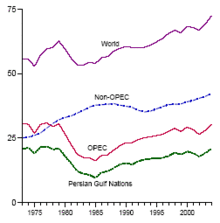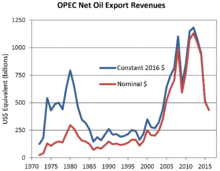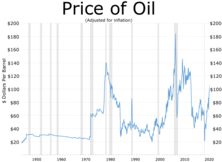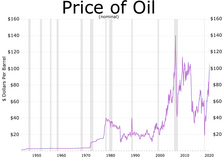1980s oil glut
This article needs additional citations for verification. (January 2023) |

The 1980s oil glut was a significant surplus of crude oil caused by falling demand following the 1970s energy crisis. The world price of oil had peaked in 1980 at over US$35 per barrel (equivalent to $129 per barrel in 2023 dollars, when adjusted for inflation); it fell in 1986 from $27 to below $10 ($75 to $28 in 2023 dollars).[2][3] The glut began in the early 1980s as a result of slowed economic activity in industrial countries due to the crises of the 1970s, especially in 1973 and 1979, and the energy conservation spurred by high fuel prices.[4] The inflation-adjusted real 2004 dollar value of oil fell from an average of $78.2 in 1981 to an average of $26.8 per barrel in 1986.[5]
In June 1981,
After 1980, reduced demand and increased production produced a glut on the world market. The result was a six-year decline in the price of oil, which reduced the price by half in 1986 alone.[2]
Production

Non-OPEC
During the 1980s, reliance on Middle East production dwindled as commercial exploration developed major non-OPEC oilfields in Siberia, Alaska, the North Sea, and the Gulf of Mexico,[11] and the Soviet Union became the world's largest producer of oil.[12] Smaller non-OPEC producers including Brazil, Egypt, India, Malaysia, and Oman doubled their output between 1979 and 1985, to a total of 3 million barrels per day.[13]
United States
In April 1979, U.S. President
Additionally, the Trans-Alaska Pipeline System began pumping oil in 1977. The Alaskan Prudhoe Bay Oil Field entered peak production, supplying 2 million bpd of crude oil in 1988, 25 percent of all U.S. oil production.[16]
North Sea
Phillips Petroleum discovered oil in the
OPEC
From 1980 to 1986,
OPEC's membership began to have divided opinions over what actions to take. In September 1985,
Reduced demand
OPEC had relied on the price inelasticity of demand of oil to maintain high consumption, but underestimated the extent to which other sources of supply would become profitable as prices increased. Electricity generation from coal, nuclear power and natural gas;[23] home heating from natural gas; and ethanol blended gasoline all reduced the demand for oil.[citation needed]
United States
New passenger
The United States imported 28 percent of its oil in 1982 and 1983, down from 46.5 percent in 1977, due to lower consumption.[2]
Brazil
Impact

The 1986 oil price collapse benefited oil-consuming countries such as the United States and Japan, countries in Europe, and developing nations but represented a serious loss in revenue for oil-producing countries in Northern Europe, the Soviet Union, and OPEC.[citation needed]
In 1981, before the brunt of the glut,
Iraq had fought a long and costly
The glut directed Algeria into an economic recession and directly influenced the politics:[32] the authoritarian regime of Chadli Bendjedid had to compromise with Islamic opposition in 1984 and start economic reforms dismantling socialism in 1987. After the 1988 October Riots he reformed the constitution twice, liberalized the political space amid growing discontent, and was ousted from office by the military after his party lost the first multi-party elections to Islamists.[citation needed]
The Soviet Union had become a major oil producer before the glut. The drop of oil prices contributed to
In the United States, domestic exploration and the number of active drilling rigs were cut dramatically. In late 1985, there were nearly 2,300 rigs drilling wells; a year later, there were barely 1,000.[35] The number of U.S. petroleum producers decreased from 11,370 in 1985 to 5,231 in 1989, according to data from the Independent Petroleum Association of America.[36] Oil producers held back on the search for new oilfields for fear of losing on their investments.[37] In May 2007, companies like ExxonMobil were not making nearly the investment in finding new oil that they did in 1981.[38]
Canada responded to high energy prices in the 1970s with the National Energy Program (NEP) in 1980. The program was in place until 1985.[citation needed]
See also
- 1980–89 world oil market chronology
- 2010s oil glut
- 2020 Russia–Saudi Arabia oil price war
References
- ^ "Crude Oil Prices – 70 Year Historical Chart". MacroTrends. Retrieved 25 May 2022.
- ^ a b c d Hershey Jr., Robert D. (30 December 1989). "Worrying Anew Over Oil Imports". The New York Times. Retrieved 30 December 2015.
- ^ Mouawad, Jad (8 March 2008). "Oil Prices Pass Record Set in '80s, but Then Recede". The New York Times. Retrieved 20 April 2010.
- ^ "Oil Glut, Price Cuts: How Long Will They Last?". U.S. News & World Report. Vol. 89, no. 7. 18 August 1980. p. 44.
- ^ Oak Ridge National Lab data[dead link]
- ^ Hershey Jr., Robert D. (21 June 1981). "How the Oil Glut Is Changing Business". The New York Times. Retrieved 30 December 2015.
- ^ a b Byron, Christopher (22 June 1981). "Problems for Oil Producers". Time. Archived from the original on 5 January 2013. Retrieved 19 January 2008.
- ^ Yergin, Daniel (28 June 1981). "The Energy Outlook; Lulled to Sleep by the Oil Glut Mirage". The New York Times.
- ^ Garvin, C. C. Jr. (9 November 1981). "The Oil Glut in Perspective". Oil & Gas Journal. Annual API Issue: 151.
- ^ EIA – International Energy Data and Analysis
- ISBN 978-0-7456-5841-4.
- ^ "World: Saudis Edge U.S. on Oil". Washington Post, 3 January 1980, p. D2.
- ^ Gately, Dermot (1986). "Lessons from the 1986 Oil Price Collapsey" (PDF). Brookings Papers on Economic Activity (2): 239. Archived from the original (PDF) on 9 May 2016. Retrieved 19 January 2016.
- ^ "Executive Order 12287 – Decontrol of Crude Oil and Refined Petroleum Products". 28 January 1981. Retrieved 27 January 2019.
- ISBN 978-0-275-96329-3. Retrieved 7 June 2010.
By September 30, 1981, petroleum prices were to be determined by the free market. This process was accelerated by President Reagan through an Executive Order
- ^ National Energy Technology Laboratory. "Fossil Energy – Alaska Oil History," Arctic Energy Office. Accessed 29 July 2009."NETL: Arctic Energy Office – Fossil Energy – Alaska Oil History". Archived from the original on 25 April 2009. Retrieved 29 July 2009.
{{cite web}}: CS1 maint: bot: original URL status unknown (link) - ISBN 978-0-521-78515-0.
- ^ Swartz, Kenneth I. (16 April 2015). "Setting the Standard". Vertical Magazine. Archived from the original on 18 April 2015. Retrieved 18 April 2015.
- ^ Warsh, David (28 February 1982). "The economy: the Oil Glut deepens; OPEC's grip loosens; but a boom or a bomb could spur prices back up". The Boston Globe.
- ^ ISBN 0-671-50248-4.
- ^ Koepp, Stephen (14 April 1986). "Cheap Oil!". Time. Archived from the original on 11 January 2013. Retrieved 19 January 2008.
- (PDF) from the original on 3 December 2007. Retrieved 4 January 2008.
- ^ Portney, Paul R.; Parry, Ian W.H.; Gruenspecht, Howard K.; Harrington, Winston (November 2003). "The Economics of Fuel Economy Standards". Resources for the Future. Archived from the original on 1 December 2007. Retrieved 4 January 2008.
- ^ "OPEC Revenues Fact Sheet". US Energy Information Administration. 10 January 2006. Archived from the original on 7 January 2008.
- ^ "OPEC Revenues Fact Sheet". U.S. Energy Information Administration. 14 June 2016. Retrieved 25 August 2016.
- ISBN 978-0-520-26235-5.
- ISBN 978-0-7894-8805-3.
- ^ "Venezuela Inflation rate (consumer prices)". Indexmundi. 2010. Retrieved 16 August 2010.
- ^ Thornton, Ted (12 January 2007). "The Gulf Wars: Iraq Occupies Kuwait". Northfield Mount Hermon School. Archived from the original on 17 December 2007. Retrieved 14 January 2008.
- ^ a b Rousseau, David L. (1998). "History of OPEC" (PDF). University of Pennsylvania. Archived from the original (PDF) on 27 February 2008. Retrieved 12 January 2008.
- ^ "A political economy of low oil prices in Algeria".
- ^ Gaidar, Yegor (April 2007). "The Soviet Collapse: Grain and Oil" (PDF). American Enterprise Institute.
Oil production in Saudi Arabia increased fourfold, while oil prices collapsed by approximately the same amount in real terms. As a result, the Soviet Union lost approximately $20 billion per year, money without which the country simply could not survive.
- ^ McMaken, Ryan (7 November 2014). "The Economics Behind the Fall of the Berlin Wall". Mises Institute.
High oil prices in the 1970s propped up the regime so well, that had it not been for Soviet oil sales, it's quite possible the regime would have collapsed a decade earlier.
- ^ Gold, Russell (13 January 2015). "Back to the Future? Oil Replays 1980s Bust". The Wall Street Journal. Retrieved 16 January 2016.[permanent dead link]
- ^ Penty, Rebecca; Shauk, Zain (21 January 2015). "Crude Collapse Has Investors Braced for '80s-Like Oil Casualties". Bloomberg. Retrieved 16 January 2016.
- ^ "Oil, Oil Everywhere". Forbes. 24 July 2006. Archived from the original on 8 January 2008. Retrieved 6 January 2008.
- ^ Fox, Justin (31 May 2007). "No More Gushers for ExxonMobil". Time. Archived from the original on 13 January 2008. Retrieved 8 January 2008.
Further reading
- World Hydrocarbon Markets: Current Status, Projected Prospects, and Future Trends, (1983), By Miguel S. Wionczek, ISBN 0-08-029962-8
- The Oil Market in the 1980s: A Decade of Decline, (1992), by Siamack Shojai, Bernard S. Katz, Praeger/Greenwood, ISBN 0-275-93380-6




